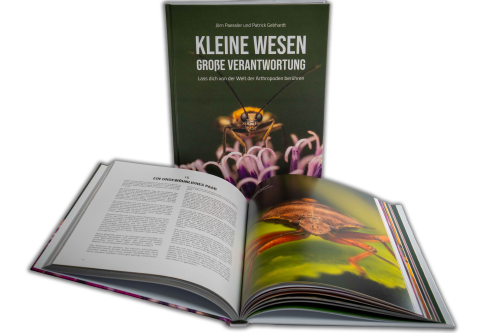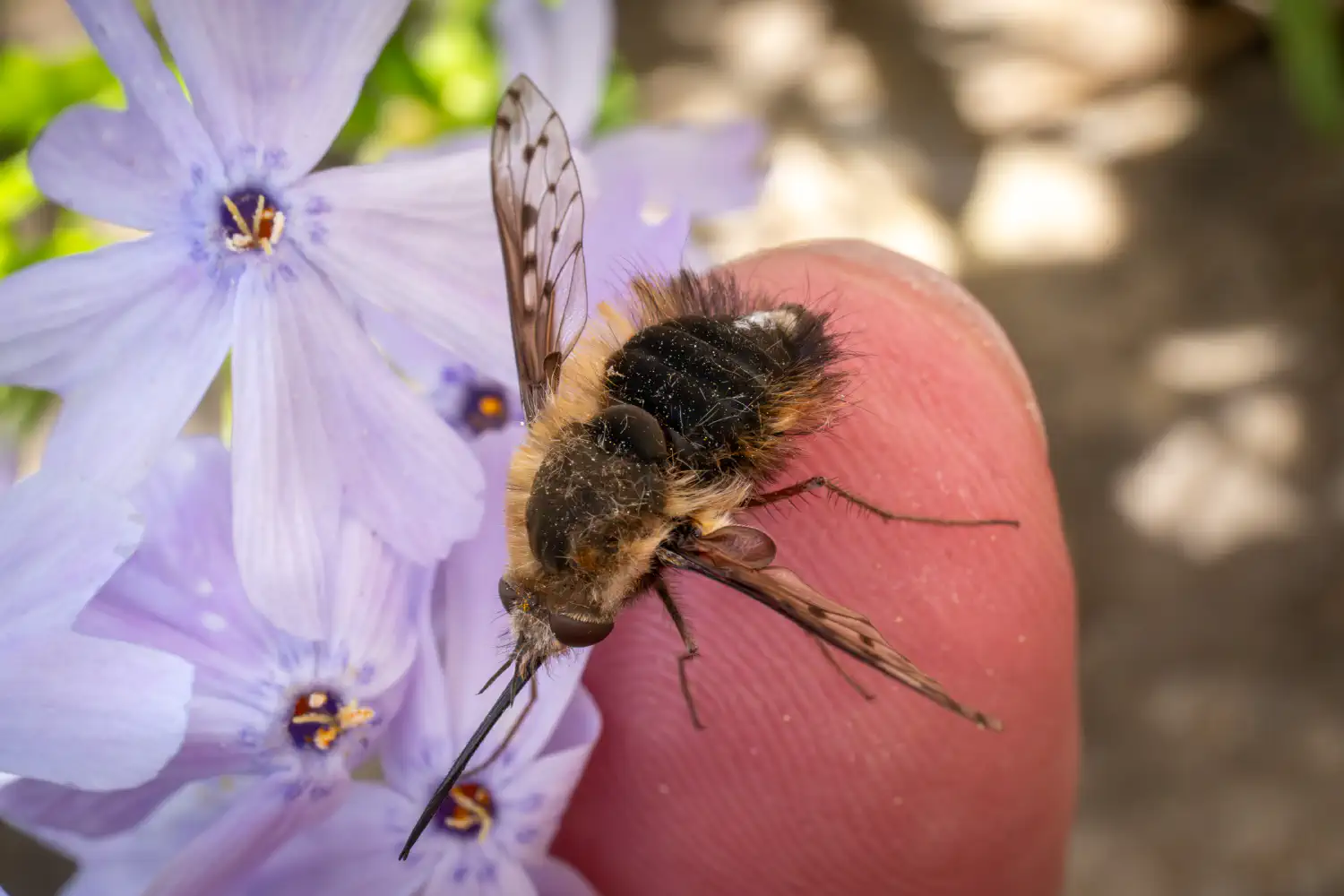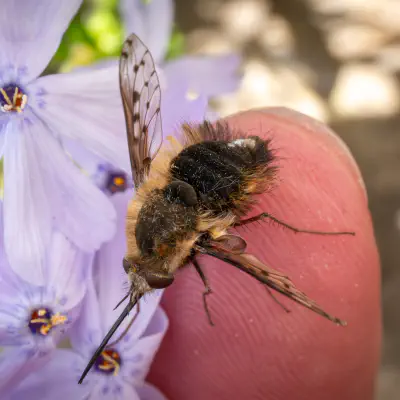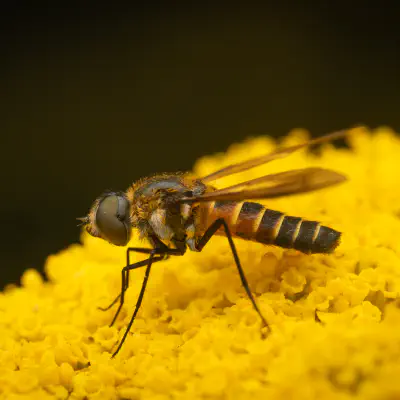Bee Flies Lat. “Bombyliidae“
The Bombyliidae are a family of flies. Their common name is bee flies. Adults generally feed on nectar and pollen, some being important pollinators. Larvae generally are parasitoids of other insects.
Hierarchy
Overview
The Bombyliidae are a large family of flies comprising hundreds of genera, but the life cycles of most species are poorly known, or not at all. Their size varies between species ranging from 2 mm long to a 40 mm wingspan making them some of the largest flies. When at rest, many species hold their wings at a characteristic “swept back” angle. Adults generally feed on nectar and pollen, some being important pollinators, often with spectacularly long proboscises adapted to plants such as Lapeirousia species with very long, narrow floral tubes. Unlike butterflies, bee flies hold their proboscis straight, and cannot retract it. Many Bombyliidae superficially resemble bees and accordingly the prevalent common name for a member of the family is bee fly. Possibly the resemblance is Batesian mimicry, affording the adults some protection from predators. The larval stages are predators or parasitoids of the eggs and larvae of other insects. The adult females usually deposit eggs in the vicinity of possible hosts, quite often in the burrows of beetles, wasps, or solitary bees. Although insect parasitoids are usually fairly, often highly, host-specific, some Bombyliidae are opportunistic and will attack a variety of hosts. The Bombyliidae include at least 4,500 described species, and certainly thousands more remain to be described. However, most species do not often appear in abundance, and compared to other major groups of pollinators they are much less likely to visit flowering plants in urban parks or suburban gardens. As a result, this is arguably one of the most poorly known families of insects relative to its species richness. The family has a patchy fossil record, with species being known from a handful of localities, the oldest known species are known from the Middle Cretaceous Burmese amber, around 99 million years old.
Biology
Adults favour sunny conditions and dry, often sandy or rocky areas. They have powerful wings and are found typically in flight over flowers or resting on the bare ground exposed to the sun (watch video) They significantly contribute to cross pollination of plants, becoming the main pollinators of some plant species of desert environments. Unlike the majority of nectar-feeding flies, the bee flies feed on pollen which provides essential proteins for their diet. A similar trophic behavior occurs among the hoverflies, another important family of Diptera pollinators.
Zoogeography
The family is worldwide (Palearctic realm, Nearctic realm, Afrotropical realm, Neotropical realm, Australasian realm, Oceanian realm, Indomalayan realm), but they are most diverse in tropical and subtropical arid climates.
Species lists
West Palaearctic including Russia Australasian/Oceanian Nearctic Japan World list
Systematics
The systematics of bee flies are the most uncertain of any family of lower Brachycera. Willi Hennig (1973) placed the bee flies in the superfamily of Nemestrinoidea, on the basis of analogies in the behaviour of the larvae, positioning the superfamily in Tabanomorpha inside the infraorder Homoeodactyla Boris Rohdendorf (1974) dealt with the family in a separate superfamily (Bombyliidea), linking it to the superfamily of Asilidea. Currently the close correlation either positions the bee-flies within the superfamily Asiloidea sensu Rohdendorf (Asilidea) or they are included with the families separated by Rohdendorf in the superfamily of Asiloidea.
The internal systematic of bee-flies is uncertain. In the past, 31 subfamilies were well defined, but the family is thought to be polyphyletic (sensu lato). In the 1980s and ’90s, the family has undergone several revisions: Webb (1981) finally moved the genus Hilarimorpha into their own family (Hilarimorphidae). Zaitzev (1991) moved the genus Mythicomyia and several other minor genera in the family Mythicomyiidae, Yeates (1992, 1994) shifted the entire subfamily of Proratinae, with the exception of Apystomyia, into the family of Scenopinidae and subsequently the genus Apystomyia into the family Hilarimorphidae. Nagatomi & Liu (1994) moved Apystomyia into a family of their own (Apystomyiidae. After these revisions, the bee flies sensu stricto have a greater morphological homogeneity, but the monophyly of the family still remains dubious. Phylogenetic analysis of CAD and 28S rDNA gene sequences supports monophyly of only eight subfamilies out of fifteen included in the study, with the Bombyliinae resolving as a highly polyphyletic group. Overall, the family includes about 4700 described species, distributed among 270 genera. The internal arrangement varies according to the source, according to the different frameworks the authors attribute to tribes and subfamilies. To divide the family, often this scheme is used:
Further reading
Bowden, J. (1980). “Family Bombyliidae”. In Crosskey, Roger Ward (ed.). Catalogue of the Diptera of the Afrotropical Region. London: British Museum (Natural History). pp. 381–430. Engel, E.O. (1932–1937). “Bombyliidae”. In Lindner, Erwin (ed.). Die Fliegen der paläarktischen Region 4(3). Stuttgart: E. Schweizerbart. pp. 1–619, pls 1-15. Greathead, David J.; Evenhuis, Neal Luit (1997). “Family Bombyliidae”. In Papp, L.; Darvas, B. (eds.). Contributions to a manual of Palaearctic Diptera. Vol. 2. Budapest: Science Herald. pp. 487–512. Evenhuis, Neal Luit (1991). “Catalog of genus-group names of bee flies (Diptera: Bombyliidae)”. Bishop Museum Bulletins in Entomology. 5: 1–105. Evenhuis, Neal Luit; Greathead, David J. (1999). World catalog of bee flies (Diptera: Bombyliidae). Leiden: Backhuys Publishers. pp. 1–756. Hull, F.M. (1973). Bee flies of the world. The genera of the family Bombyliidae. Washington: Smithsonian Institution Press. pp. 1–687. Yeates, David K. (1994). The cladistics and classification of the Bombyliidae (Diptera: Asiloidea). Vol. 219. New York: American Museum of Natural History. pp. 1–191. hdl:2246/826.
External links
Image Gallery from Diptera.info Bombyliidae (Bee Flies) by David K. Yeates and Christine L. Lambkin in the Tree of Life web project. Consulted March 28, 2007. Wing venation
Ancestry Graph
Further Information
„Bee Flies“ on iNaturalist.org
Copyright

This article uses material from the Wikipedia article Bombyliidae the free encyclopedia Wikipedia which is released under Creative Commons Attribution-ShareAlike 4.0 International License). On Wikipedia a list of authors is available.

Little beings in print
Order our calendars and books today!
Compiled with love. Printed sustainably. Experience our little beings even more vividly in print. All our publications are available for a small donation.



